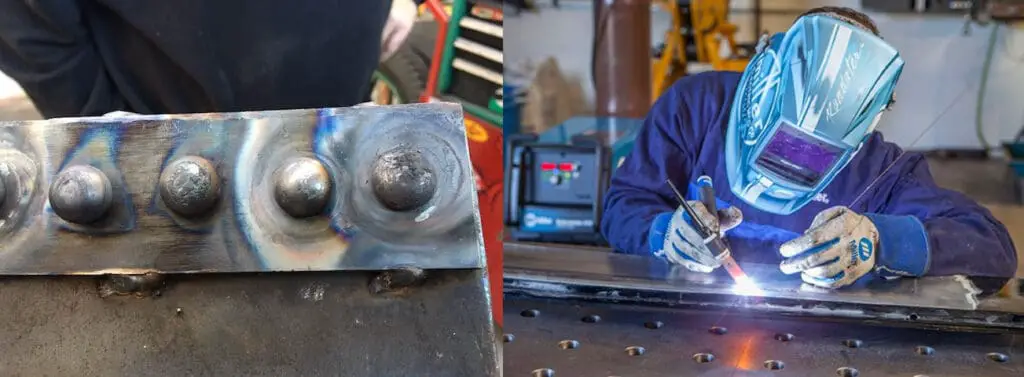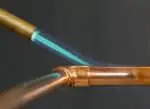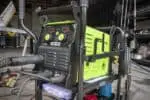Choosing the appropriate metal joining technique is critical because it ensures the structural and commercial integrity of your product.
When deciding on the best joining method, there are various aspects to consider. Let us talk about two of them- welding and riveting.
Welding is a common procedure used in the fabrication industry to combine comparable or different materials. This sculpting procedure is typically carried out at a certain temperature and pressure. High heat is created during this procedure to bind the components together.
Riveting is a type of forging procedure that may be used to attach pieces. A rivet is a mechanical fastening that is made up of a cylindrical shaft. The head of a rivet is formed like a dome, while the tail is fashioned like a cylinder.
While riveting has its uses, there are several instances in which welding outperforms riveting in terms of strength and durability. When we examine the forces that can pull components apart, a correctly welded joint is stronger than a riveted joint. As a result, for bond strength, welding should be recommended.
Before we understand why welding is better than riveting, let us know the differences between the two-
| Welding | Riveting |
| Metal joining procedure that is permanent. | Semi-permanent. |
| Welding creates a stiff junction that is stronger than a riveted joint. | Rivets are used to keep metal sheets together, they are not as stiff and are also weaker than welded joins. |
| There is no connecting component utilised. As a result, it is lighter. | It is heavier because connecting components such as gusset plates are employed. |
| Welding can be performed on any area of the structure. | Riveting requires a certain amount of space between them. |
| Thermal expansion may result in additional internal tension in the weld joint. | It gives a tolerance in order to prevent the issue of thermal expansion. |
| Welding can be done even if only one face of the structure is accessible. | Riveting is impossible if we don’t have access to both sides. |
| Welding may cause cell structural damage due to the heating involved. | There is no heating involved. |
| It is quite simple to make changes and additions to an existing structure. | Addition and modification are not as simple as welding. |
| It is quicker than fascinating. | The procedure is time-consuming. |
| Inspection is really challenging. | It is easier to inspect. |
Let’s talk about uses of both welding and riveting.
Welding- Welding produces lighter structures, which make structures heavier with each rivet added. Because the two original materials are totally fused, the strength of a welded junction is likewise increased.
Also, the resultant smooth surface is frequently more appealing than riveted materials. Finally, there are less restrictions on where you may build a welded junction than there are when inserting a rivet since rivets require a specific amount of space to operate properly.
Riveting- Welding tends to need more expert work than riveting, and opting for welding means opting for a more difficult operation.
One of the most problematic aspects of welding joints is that materials are likely to alter characteristics at greater temperatures, making them prone to deformation.
Aluminum, which is utilised in aeroplanes, is a difficult material to weld properly, hence rivets are required. Small fractures or distortions can often be difficult to notice.
As a result, before selecting between welding and riveting, it is critical to thoroughly analyze the scientific properties of the metals being used.
Pros and cons of welding and riveting
Advantages of welding
1.) Welded constructions are often substantially lighter than riveted structures.
2.) Welded materials are often substantially more efficient than riveted materials.
3.) Welded connections are significantly easier to modify than riveted joints.
4.) Welds are more visually appealing than riveted joints.
5.) Welded constructions are also significantly stronger than riveted structures.
6.) Welded joints often require less time than riveted connections.
7.) It is easier to weld cylindrical forms such as pipes than it is to rivet them.
8.) Welded connections are often significantly stronger than riveted joints.
Advantages of riveting
1.) Riveting is quite dependable. Rivets are often made of stronger materials, which aids in their structural integrity.
2.) Non-ferrous materials can be riveted.
3.) Inspecting the quality of riveting is inexpensive (and reasonably straightforward).
4.) When riveted joints are disassembled, they sustain less damage.
5.) Riveted components have no thermal aftereffects.
6.) There are several varieties of solid rivets, so you have some leeway in how you use them.
7.) You may build a joint in any position (above, flat, vertical, overhead).
8.) Riveting emits no vapors or odors.
Disadvantages of welding
1.) Welded joints using weld symbols necessitate a highly experienced welder.
2.) Welding’s uneven heating and cooling process can deform the materials being welded.
3.) Because there are no accommodations for expansion and contraction, the chance of fractures occurring in the weld is increased.
4.) Inspecting welding flaws is far more time-consuming than riveting work.
Disadvantages of riveting
1.) There is a concentration of tension at the rivet hole.
2.) A riveted joint is more expensive.
3.) Riveting generates a lot of noise.
4.) They are more substantial than welds (at least, the joints are).
5.) Riveting work is more costly than other types of labour.
6.) The metal substance used to secure the rivets deteriorates.
So what makes Welding better than Riveting?
1.) Smooth constructions: After welding, you will have smooth structures. Smooth welding structures are quite appealing, however rivet structures are never smooth.
2.) Clearance: Welding engineers may readily join any section of metal with the use of welding techniques, however riveting requires enough clearance.
3.) Strength: Welded joints are significantly stronger than riveted joints.
4.) Efficiency: Welded junctions are usually extremely efficient, whereas riveted joints have a lower total efficiency.
5.) Additions and modifications: When compared to a riveted structure, welding constructions allow for easier additions and alterations.
6.) Weight: When compared to welded constructions, riveted structures are often heavier. Gussets are not employed in the welding procedure because of this.
7.) Time: Another significant advantage is that welding takes significantly less time than riveting.
8.) Cylindrical forms: Cylindrical shapes can be easily welded, however riveting is not an option for these shapes.
9.) Durability: The welding connections are extremely robust and long-lasting. They are not readily bent. Welding, rather than riveting, is used to construct modern rigid frames.
10.) Tension members: Unlike riveted connections, tension members cannot be weakened during the welding process.
Conclusion
Riveting and welding are critical in a variety of industries throughout the world. Both have provided significant strength and have contributed significantly to the development of the structure or framework of modern developments.
They are both frequently used procedures for forming a joint between two or more metal surfaces. The choice of which one to utilise is determined by the worker’s goals.
Welding, in general, is not recommended everywhere. It is dependent on a variety of engineering factors. Both procedures are critical in many sectors, but welding outperforms riveting in terms of efficiency, durability, and strength.






